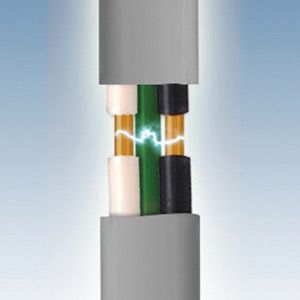We may be compensated if you purchase through links on our website. Our team is committed to delivering honest, objective, and independent reviews on home products and services.
About half of home electrical fires result from shorts, also known as arc faults. These can happen for a number of reasons, including frayed or damaged electrical cords, loose wire connections, nails or screws driven into wires behind walls, or simply natural aging of electrical components.
In this guide, we’ll explain what arc faults are, how they happen, and how you can prevent them.
What Are Arc Faults?
Arc faults occur when electricity escapes from its intended path, which can generate heat and potentially cause fires. These arcs can reach temperatures of 10,000 degrees Fahrenheit, and fires that start this way are particularly dangerous because they often occur in wall cavities, attics, and other places where a smoke alarm can’t detect them until it’s too late.
There are two main types of arc faults: parallel arc faults and series arc faults. Understanding the differences, causes, detection, and prevention methods is crucial for maintaining electrical safety in homes.
Parallel Arc Fault
A parallel arc fault occurs when electricity “jumps” between two conductors, usually the hot (live) and neutral wires, or between the hot wire and ground. This creates a path of lower resistance, causing a high current that generates a significant amount of heat. These faults are particularly dangerous because they can easily cause electrical fires.

Parallel arc faults typically occur due to:
- Damaged insulation: Worn-out or frayed insulation on wires can expose conductors, allowing electricity to arc between them.
- Loose connections: Improperly installed or loose connections between wires and terminals can cause electrical arcs.
- Pinched or crushed wires: If wires are pinched or crushed (e.g., behind walls or under heavy furniture), the insulation may become damaged, leading to a parallel arc.
- Water damage: Moisture or water intrusion can bridge conductors, leading to a parallel arc fault.
Series Arc Fault
A series arc fault occurs when there is a break or weak point in a single wire (either the hot, neutral, or ground) that causes intermittent arcing as electricity tries to jump across the gap. This type of arc produces less current than a parallel arc, but it can still generate enough heat to cause a fire over time.

Series arc faults typically occur due to:
- Damaged or broken wires: If a wire becomes damaged or partially broken, the electrical connection may arc across the gap, causing heat buildup.
- Excessive bending or flexing of wires: Repeated bending or flexing of wires can cause them to break down internally, leading to a series arc fault.
- Loose wire connections: When a wire isn’t securely fastened to a terminal (like in an outlet or switch), small gaps can develop, allowing electricity to arc.
- Worn-out switches or outlets: Over time, the connections inside switches, outlets, or other electrical components can degrade, leading to arcing.
What Are Arc-Fault Circuit Interrupters (AFCIs)?
In both cases, an arc-fault circuit interrupter is the best way to detect and stop an arc fault.
You can’t depend on a standard circuit breaker to stop arc faults because arc faults are usually too brief and too low a current to trip a circuit breaker. But an AFCI device that can detect and automatically shut down an arcing circuit.
AFCIs have proven so effective at preventing electrical fires that the National Electrical Code (NEC) requires AFCIs be installed in almost every room in newly built houses. Bathrooms, garages, and unfinished basements—areas defined as non-living spaces—are among the few exceptions. The NEC also requires the installation of AFCIs in existing homes whenever an addition, extra circuit, or extra outlet is added.
How Do AFCIs Work?
AFCIs use sophisticated electronics to monitor the electrical current in a circuit. They look for specific patterns in the electrical waveform that indicate an arc fault. When an AFCI detects these telltale signs, it quickly interrupts the power, preventing the arc from continuing and potentially starting a fire.
“AFCIs are engineered to sense minute, fleeting fluctuations in the frequency and amplitude of the electricity’s 60-cycle-per-second waveform,” says Bill Grande, senior director of product management at Leviton. This technology allows AFCIs to differentiate between normal electrical activity and dangerous arc faults.
What Are the Two Main Types of AFCIs?
There are two main types of AFCIs available for home use: combination AFCIs and outlet-branch circuit (OBC) AFCIs. Both types offer excellent protection, but combination AFCIs provide more comprehensive coverage. OBC AFCIs are often easier to install in existing homes without replacing the entire breaker panel.
Combination AFCIs
Circuit-breaker AFCIs–known as combination AFCIs–are typically more expensive, may not fit in older circuit-breaker panels, and should be installed by an electrician.
OBC AFCIs
Outlet-branch circuit (OBC) AFCIs are as easy to install. They cost about $30, and they’re easy to test and reset if they trip. Leviton’s 15-amp AFCI, for instance, has a green LED that tells you it’s actively monitoring the circuit. When that light goes out, you know the AFCI has tripped.
OBC AFCIs do not need to be installed in every outlet in a room. When one is placed in the first outlet on a branch circuit, it will protect everything downstream from that location–including any device, appliance, or fixture plugged into the outlets on that circuit.
If you don’t know which outlet is first in the branch, contact an electrician or follow this procedure recommended by Leviton’s Grande:
- Shut off the breaker to the circuit and remove the outlet you suspect is the first in the circuit.
- Cap the wires and turn the breaker back on.
- Test the other outlets by plugging in a work light. If you chose correctly, they will all be dead.
- If you chose incorrectly, replace the original outlet and repeat the process after removing another outlet.
What Are the Differences Between AFCIs and GFCIs?
AFCIs look similar to ground-fault circuit interrupters (GFCIs), which have long been required for outlets in kitchens, bathrooms, garages, and other damp locations. Both GFCIs and AFCIs have two buttons: one for testing the device and one for resetting it after a trip. However, a GFCI performs an entirely different function: it shuts down current flowing outside a circuit to the ground, guarding against shocks that can injure or even kill a person.
What To Do if Your AFCI Trips
It is not wise to push the “reset” button and hope the problem will go away. The device is signaling that there’s an arc somewhere in the circuit, and it should tracked down and fixed. In many cases, Grande says, arcing occurs in an appliance, cord, or light that’s plugged into the AFCI-protected circuit. In that instance, disconnecting the faulty item from the receptacle should restore the circuit’s safety.
If an AFCI trips even after all plugged-in items are removed, then the problem is likely with the wiring inside the walls. Call an electrician for a diagnosis. He or she will inspect all the connections and, if necessary, replace the entire circuit.
For more information on AFCIs, please go to leviton.com/afci.

